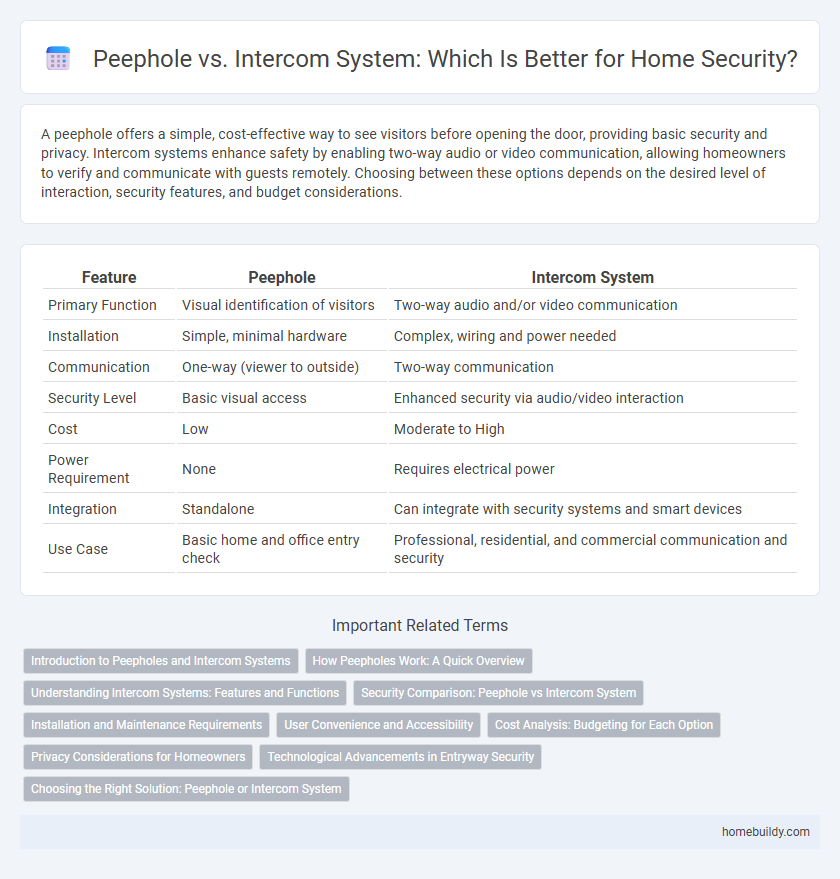A peephole offers a simple, cost-effective way to see visitors before opening the door, providing basic security and privacy. Intercom systems enhance safety by enabling two-way audio or video communication, allowing homeowners to verify and communicate with guests remotely. Choosing between these options depends on the desired level of interaction, security features, and budget considerations.
Table of Comparison
| Feature | Peephole | Intercom System |
|---|---|---|
| Primary Function | Visual identification of visitors | Two-way audio and/or video communication |
| Installation | Simple, minimal hardware | Complex, wiring and power needed |
| Communication | One-way (viewer to outside) | Two-way communication |
| Security Level | Basic visual access | Enhanced security via audio/video interaction |
| Cost | Low | Moderate to High |
| Power Requirement | None | Requires electrical power |
| Integration | Standalone | Can integrate with security systems and smart devices |
| Use Case | Basic home and office entry check | Professional, residential, and commercial communication and security |
Introduction to Peepholes and Intercom Systems
Peepholes are small optical devices installed in doors, enabling residents to view visitors discreetly without opening the door, enhancing security at a basic level. Intercom systems employ electronic communication technology to facilitate two-way audio or video interaction between visitors and occupants, offering advanced convenience and security features. Both systems serve to verify visitor identity but differ significantly in functionality, installation complexity, and user experience.
How Peepholes Work: A Quick Overview
Peepholes operate using a fisheye lens that provides a wide-angle view of the area outside a door, allowing residents to identify visitors without opening the door. Unlike intercom systems, peepholes do not require electrical power or complex installation, making them a simple and cost-effective security solution. Their optical design enables clear visibility in various lighting conditions while ensuring privacy and ease of use.
Understanding Intercom Systems: Features and Functions
Intercom systems offer advanced communication features such as two-way audio, video connectivity, and remote access, enabling users to screen visitors and control entry points from anywhere. These systems integrate with smartphones and security platforms, enhancing convenience and safety beyond the limited field of view provided by peepholes. By combining multiple functions like door release and real-time alerts, intercoms provide comprehensive access control suited for modern residential and commercial environments.
Security Comparison: Peephole vs Intercom System
Peepholes offer a simple, low-cost security solution by allowing residents to visually confirm visitors before opening the door, with no risk of hacking or electronic failure. Intercom systems provide enhanced security features such as two-way audio communication, video monitoring, and remote access control, enabling users to verify identity from a distance and maintain a communication log. While peepholes rely solely on direct line-of-sight and manual checking, intercom systems integrate advanced technology to improve visitor screening and overall home security.
Installation and Maintenance Requirements
Peephole installation requires minimal effort, involving drilling a small hole in the door, making it a cost-effective and quick solution with virtually no ongoing maintenance. In contrast, intercom systems demand professional installation for wiring or wireless setup, often requiring compatibility checks and regular software updates or hardware servicing. Maintenance for peepholes is limited to cleaning the lens, whereas intercom systems need periodic inspections to ensure audio/video clarity and connectivity stability.
User Convenience and Accessibility
Peepholes offer direct, real-time visual access to visitors without requiring power or electronic setup, ensuring immediate convenience and simplicity. Intercom systems provide enhanced communication capabilities, including audio interaction and remote unlocking, improving accessibility for users with mobility challenges. Choosing between the two depends on balancing the need for straightforward, low-maintenance use versus integrated, technology-driven access control.
Cost Analysis: Budgeting for Each Option
Peepholes offer a low-cost security solution with installation expenses typically under $20, making them ideal for budget-conscious homeowners. Intercom systems require a higher initial investment, often ranging from $150 to $1,000 depending on features like video capability and multi-room connectivity. Budgeting for an intercom system should also include potential maintenance and installation fees, which can significantly increase the total cost compared to the minimal upkeep of a peephole.
Privacy Considerations for Homeowners
Peepholes offer enhanced privacy by allowing homeowners to discreetly view visitors without revealing their presence, unlike intercom systems that transmit audio and video data potentially vulnerable to hacking. Unlike intercoms connected to Wi-Fi or other networks, peepholes operate offline, minimizing the risk of digital breaches and unauthorized access to personal information. For privacy-conscious homeowners, peepholes provide a secure, low-tech solution that avoids the data exposure concerns associated with smart intercom devices.
Technological Advancements in Entryway Security
Peepholes provide a basic, mechanical method for identifying visitors through a small lens, offering limited visibility and no recording capabilities. Intercom systems incorporate advanced technology such as two-way audio, video surveillance, and remote access via smartphones, significantly enhancing entryway security. Modern intercoms integrate seamlessly with smart home devices, enabling real-time monitoring and control beyond the capabilities of traditional peepholes.
Choosing the Right Solution: Peephole or Intercom System
Peepholes offer a simple, cost-effective way to visually verify visitors directly through the door, providing immediate security without the need for electrical power or network connectivity. Intercom systems enhance communication by allowing two-way audio or video interaction, ideal for multi-unit buildings or remote access control, but they require installation and maintenance. Choosing the right solution depends on factors such as building type, security needs, budget, and desired level of interaction with visitors.
Peephole vs Intercom System Infographic

 homebuildy.com
homebuildy.com